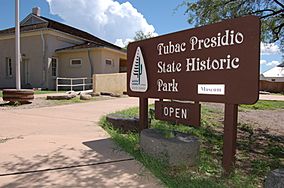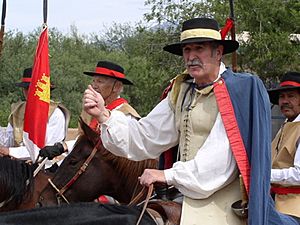Tubac Presidio State Historic Park facts for kids
Quick facts for kids Tubac Presidio State Historic Park |
|
|---|---|

Entrance to Tubac Presidio State Historic Park
|
|
| Location | Santa Cruz, Arizona, United States |
| Elevation | 3,500 ft (1,100 m) |
| Established | 1958 |
| Named for | Presidio San Ignacio de Tubac |
| Visitors | 6,620 (in 2022) |
| Governing body | Arizona State Parks |
| Website | https://www.tubacpresidio.org/ |
Tubac Presidio State Historic Park is a special place in Tubac, Arizona, USA. It protects the old ruins of the Presidio San Ignacio de Tubac and other historic buildings. This park helps us understand how Europeans first settled in this part of Southern Arizona.
At the park, you can explore a museum and several historic sites. There's even an underground exhibit where you can see the original foundations of the Tubac Presidio. It's a great spot for a picnic too! The park hosts fun events all year, like Anza Days in October. You can also see "Los Tubaqueños" living history shows on Sundays from October to March. These shows bring the past to life!
The park was once managed by Arizona State Parks. It's actually the very first park in the Arizona state park system. In 2010, the park was almost closed due to money problems. But local people and the Tubac Historical Society stepped in to save it! Now, a group called The Friends of the Presidio runs the park with the help of amazing volunteers.
Contents
Exploring Tubac's Past
Early Spanish Settlements
Long ago, the Spanish Empire wanted to expand into new lands. They built Catholic missions across what is now Mexico and the southwestern United States. One such mission was built nearby at Tumacácori in 1691. Tubac, which was a small village for the Pima people at the time, became a farm and ranch for the mission.
Spanish settlers began moving to the area in the 1730s. About 20 years later, in 1751, the Pimas, led by Luis of Saric, rebelled against the Spanish. The settlement at Tubac was destroyed. The Pimas surrendered a year later. To protect the town from future uprisings, the Presidio San Ignacio de Tubac was built. This made Tubac the very first European settlement in what is now Arizona!
Anza's Journey and Apache Raids
In the 1770s, the Spanish worried about a Russian fort being built north of the San Francisco Bay area. So, they sent Juan Bautista de Anza to find a land route to San Francisco. He also needed to establish a fort and mission there. De Anza's group passed through Tubac in early 1774.
In 1776, the soldiers from Tubac were moved north to Tucson. This left Tubac unprotected from attacks by the Apache people. Because of this, the presidio was reopened in 1787. This time, it had Pima/O'odham Indian soldiers and Spanish officers.
Changes in Control and Growth
Tubac became part of an independent Mexico in 1821. Later, in 1854, it became part of the United States because of the Gadsden Purchase. When Americans arrived, a man named Charles D. Poston started the Sonora Exploring and Mining Company in Tubac.
Poston did many important things for the town. He performed weddings, granted divorces, and even printed his own money to pay his workers! In 1859, he started Arizona's first newspaper. The next year, Tubac was the biggest town in the state.
Decline of Tubac's Importance
Sadly, Tubac's good times did not last. Soldiers from the area were called away to fight in the American Civil War. This left the town unprotected from Apache raids once again. Also, the main railroad went through Tucson to the north. Silver was also discovered around Tombstone to the east. These changes meant that Tubac never became as important as it once was.
Park Features and Fun Events
Exploring the Presidio Ruins
The most important part of the exhibits at Tubac Presidio State Historic Park is the underground display of the presidio's foundations. Archeologists from the University of Arizona dug up these foundations in 1974. Visitors can now see parts of the presidio's original walls and foundations.
Historic Buildings to See
You can also step inside the 1885 schoolhouse, which looks just like it did back then. It has old desks, chalkboards, and a potbelly stove. Other buildings at the park include the 1914 Otero Hall, which has different exhibits. There's also the Rojas House, where the same family lived for about 100 years.
The park's museum shows items from different times in Tubac's history. These include artifacts from American Indian times (before 1752), Spanish Colonial times (1752–1821), Mexican Republic times (1821–1854), and Anglo Territorial times (1854–1912).
Right next to the park is St. Ann's Church. It was built on the ruins of an older church called Iglésia de Santa Gertrudis. You can also find the start of the Tubac-to-Tumacácori part of the Juan Bautista de Anza National Historic Trail here.
Annual Anza Days Celebration
Every October, the park celebrates Anza Days. This event remembers when Juan Bautista de Anza arrived at the Tubac Presidio. Actors dressed in old costumes ride horses from nearby Tumacácori. They talk about de Anza's famous trip to San Francisco. The weekend event also features actors showing what life was like in different periods of Tubac's history. You can enjoy mariachi music and cowboy rope tricks too!
Images for kids









